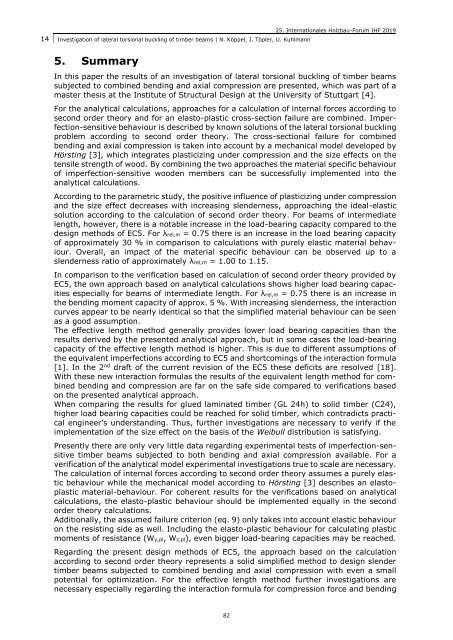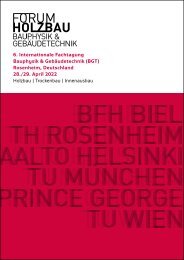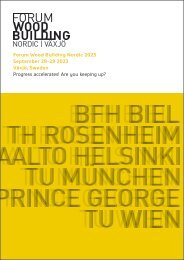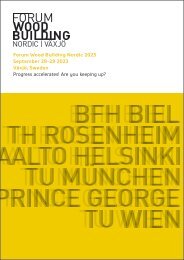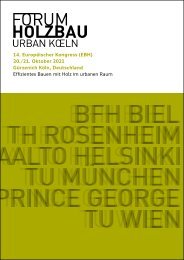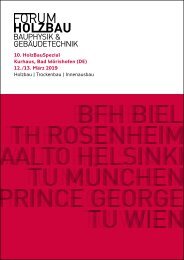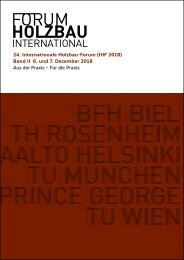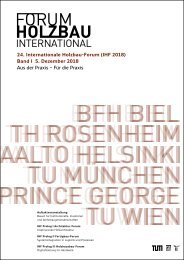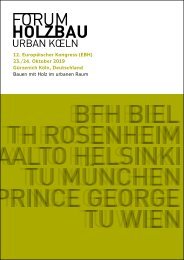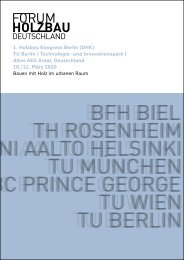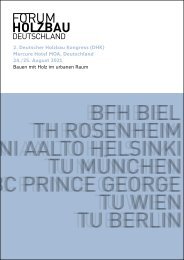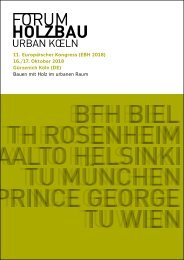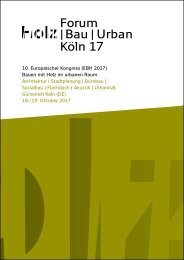25. Internationale Holzbau-Forum (IHF 2019) - Band III
Sie wollen auch ein ePaper? Erhöhen Sie die Reichweite Ihrer Titel.
YUMPU macht aus Druck-PDFs automatisch weboptimierte ePaper, die Google liebt.
14<br />
Investigation of lateral torsional buckling of timber beams | N. Köppel, J. Töpler, U. Kuhlmann<br />
<strong>25.</strong> <strong>Internationale</strong>s <strong>Holzbau</strong>-<strong>Forum</strong> <strong>IHF</strong> <strong>2019</strong><br />
5. Summary<br />
In this paper the results of an investigation of lateral torsional buckling of timber beams<br />
subjected to combined bending and axial compression are presented, which was part of a<br />
master thesis at the Institute of Structural Design at the University of Stuttgart [4].<br />
For the analytical calculations, approaches for a calculation of internal forces according to<br />
second order theory and for an elasto-plastic cross-section failure are combined. Imperfection-sensitive<br />
behaviour is described by known solutions of the lateral torsional buckling<br />
problem according to second order theory. The cross-sectional failure for combined<br />
bending and axial compression is taken into account by a mechanical model developed by<br />
Hörsting [3], which integrates plasticizing under compression and the size effects on the<br />
tensile strength of wood. By combining the two approaches the material specific behaviour<br />
of imperfection-sensitive wooden members can be successfully implemented into the<br />
analytical calculations.<br />
According to the parametric study, the positive influence of plasticizing under compression<br />
and the size effect decreases with increasing slenderness, approaching the ideal-elastic<br />
solution according to the calculation of second order theory. For beams of intermediate<br />
length, however, there is a notable increase in the load-bearing capacity compared to the<br />
design methods of EC5. For λrel,m = 0.75 there is an increase in the load bearing capacity<br />
of approximately 30 % in comparison to calculations with purely elastic material behaviour.<br />
Overall, an impact of the material specific behaviour can be observed up to a<br />
slenderness ratio of approximately λrel,m = 1.00 to 1.15.<br />
In comparison to the verification based on calculation of second order theory provided by<br />
EC5, the own approach based on analytical calculations shows higher load bearing capacities<br />
especially for beams of intermediate length. For λrel,m = 0.75 there is an increase in<br />
the bending moment capacity of approx. 5 %. With increasing slenderness, the interaction<br />
curves appear to be nearly identical so that the simplified material behaviour can be seen<br />
as a good assumption.<br />
The effective length method generally provides lower load bearing capacities than the<br />
results derived by the presented analytical approach, but in some cases the load-bearing<br />
capacity of the effective length method is higher. This is due to different assumptions of<br />
the equivalent imperfections according to EC5 and shortcomings of the interaction formula<br />
[1]. In the 2 nd draft of the current revision of the EC5 these deficits are resolved [18].<br />
With these new interaction formulas the results of the equivalent length method for combined<br />
bending and compression are far on the safe side compared to verifications based<br />
on the presented analytical approach.<br />
When comparing the results for glued laminated timber (GL 24h) to solid timber (C24),<br />
higher load bearing capacities could be reached for solid timber, which contradicts practical<br />
engineer’s understanding. Thus, further investigations are necessary to verify if the<br />
implementation of the size effect on the basis of the Weibull distribution is satisfying.<br />
Presently there are only very little data regarding experimental tests of imperfection-sensitive<br />
timber beams subjected to both bending and axial compression available. For a<br />
verification of the analytical model experimental investigations true to scale are necessary.<br />
The calculation of internal forces according to second order theory assumes a purely elastic<br />
behaviour while the mechanical model according to Hörsting [3] describes an elastoplastic<br />
material-behaviour. For coherent results for the verifications based on analytical<br />
calculations, the elasto-plastic behaviour should be implemented equally in the second<br />
order theory calculations.<br />
Additionally, the assumed failure criterion (eq. 9) only takes into account elastic behaviour<br />
on the resisting side as well. Including the elasto-plastic behaviour for calculating plastic<br />
moments of resistance (Wy,pl, Wz,pl), even bigger load-bearing capacities may be reached.<br />
Regarding the present design methods of EC5, the approach based on the calculation<br />
according to second order theory represents a solid simplified method to design slender<br />
timber beams subjected to combined bending and axial compression with even a small<br />
potential for optimization. For the effective length method further investigations are<br />
necessary especially regarding the interaction formula for compression force and bending<br />
82


